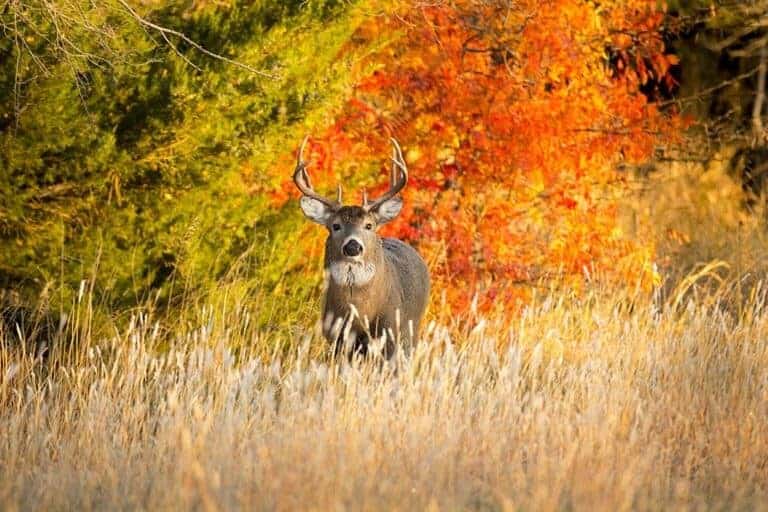It may come as a surprise to some, but whitetail deer are actually fairly vocal creatures and make many different sounds, especially during the rut. Using a grunt call can get that big buck to turn his head and come your way if you know what you are doing. Actually, the grunt call is one of the best tools we have against a buck during the rut, but the question is how often should you grunt during the rut and how should you use them? Knowing how to use a grunt call effectively will give you the best chance at that old trophy buck and will help you become a better hunter.
Grunt Frequency Depending On The Rut
Just like a lot of things with whitetail, the frequency at which you should blindly use a grunt call depends on the time of year. During the pre-rut, some bucks will be grunting and looking around for soon to be estrus does, as well as scaring off young bucks. During this time the tone of your grunt does not really matter. Every buck has a different sounding grunt and some small bucks will have deep grunts while other larger bucks will have high pitched, weak sounding grunt. During the pre-rut, it would not hurt to let out a few blind grunts every now and again, but you should avoid blind calling around food sources and bedding areas during this time. There are not many bucks grunting at this point in the rut so you do not want to single yourself out and make it obvious that you are there.
When the rut is in full swing, bucks are grunting a lot more often and are more willing to check out other grunts in hopes of stealing a hot doe. This is when you can take advantage of this and start ramping up your calling frequency to about every 30 minutes. Every blind grunt sequence should consist of three to five grunts, and be spaced about one second apart.
RELATED POST: THE WHITETAIL RUT, WHAT, WHY, & WHEN
During peak-rut, you want loud aggressive grunts. Large bucks respond to these the best, but you may run off smaller bucks and does. When you start your grunt sequence, use softer grunts, and work your way up to progressively louder and more aggressive grunts. If you start off hard, you could spook deer that are close by that you have not seen yet.
During the post-rut, you should hold back on the grunts. Bucks are not as aggressive during this time and probably will not go out of their way to investigate a grunt from far away. The best place for you to hunt during this time is around a feeding area and bedding areas. If you are hunting these places you do not need to grunt. Deer will already be moving into the areas and you do not need to attract them to you or bring attention to yourself. Though there will be a second rut and you could be successful with a few blind grunts, I would not focus on it.
To hear some examples on how the grunt is used check out this video by Knight and Hale,
Buying a Grunt Call
Grunt calls will run you anywhere from $10-$30 ish dollars typically. The more expensive calls normally have multiple settings or ways to produce different sounds but a cheap grunt tube will do the job when you are just starting out. If you are just getting into calling, many times companies will sell packages with multiple types of calls like grunts, a rattle bag, and doe bleats. One or two of those packages could complete your whitetail deer calling arsenal.
If you are looking for examples of good calls, here are two grunt calls I have and would recommend to any hunter:

It is hard to beat the simplicity and functionality of the inexpensive Primos® Power Buck & Doe™ Deer Call, you can get it at Cabelas.com for $7.88 before shipping.

If you are willing to spend a little more, you can pick up the versatile Primos® Revolver Deer Grunt that also produces doe bleats from Cabelas.com for $24.99 before shipping.
Blind Grunt Calling
You use a grunt call in two main situations. When you see a buck and he is not coming your way, and when you do not see anything and are trying to attract a buck that may be in the surrounding area. The latter is blind calling. You are blindly calling out into the woods to see if you can bring in a buck that could possibly be cruising in the surrounding area.
Blind calling works exceptionally well during most phases of the rut. When bucks are chasing a doe or running off other bucks they let out a grunt call. Naturally, other bucks will hear this from a ways off and will come to investigate. They are hoping they can steal the hot doe. I know that I talked about how you should use a blind call during different phases of the rut but, also keep in mind that you need to start off with softer blind grunts and work your way up to more aggressive ones so you do not scare any deer that are close by that you may not have seen yet.
Calling to Bucks Within Sight
If you set your stand in a position that allows you to see for a long way, chances are you will see a shooter going in a direction that will not present a shot. This is where the grunt call shines. During the rut, bucks are eager to steal does from one another. So letting out a grunt at a buck that is headed away from you is the ticket to get him to turn around.
If he stops and stares at you, do not keep grunting. That will just allow him to fixate on your position and probably get spooked. However, if you grunt and he keeps going, do not be afraid to let out a few more grunts with an aggressive flair. You can also use the aggressive snort wheeze call as a last resort.

Also, if you do grunt at a buck and he appears to walk off unaffected, do not count him out. He may circle around and come back whether you can see him or not. More likely than not he will circle off the downwind side of where he thinks the grunt came from. He does this so he can better utilize his sense of smell before he approaches a potential fight. So if he does not turn right around, make sure you are watching your downwind side for the next hour or so.
When Not to Call
While grunt calls are great, there are times when it is best to put it down and let the deer move how they want to move. Here are a few situations where you should not grunt to a buck:
- When a buck is coming toward you, or you just turned him around with a grunt. If he is headed your way and can see where the grunt is coming from but does not see another deer, he may get spooked and you will miss the opportunity at a shot.
- When a deer is looking directly at you from less than 80 yards or so, they could see you and again would be spooked.
- When a buck is already alert (because of you or not), leave him be. Grunting to him will only spook him more.
- When a buck just is not paying attention to any of your calls, let him go. Calling more will only change his patterns.
- When any deer are within 20 yards of you (even moving or looking away), this is too close to be hearing a deer that their exceptional eyes cannot see.
Conclusion
To wrap it all up, the grunt is an amazing call and can be an absolute game-changer in the field. Although you need to vary your tactics with this call depending on which phase of the rut you are currently hunting. Most of the time when using a grunt call you will be blind calling to any bucks that could possibly be in the area. The grunt sound makes bucks especially curious and possibly aggressive during the rut. With that being said, when you do see a buck that is not headed your way, you can let out a few grunts. More than likely you will get some sort of physical response, and hopefully, get him to turn around. Even though the grunt call is great, you need to know when to use it and when not to. They can potentially be too much of a good thing.
Thanks for reading my article about how often you should grunt during the rut. I hope you enjoyed it and learned something you didn’t already know. If you like my content, subscribe to my weekly update. If you have any other questions about how often you should grunt during the rut or just want to connect, feel free to email me at [email protected].
Other Resources for Grunt Calling
- North American Whitetail – Deer Grunting Tips from 3 Whitetail Experts
- Deer & Deer Hunting – Successful Calling Tips for Dominant Whitetail Bucks
- Sportsmans Guide – Calling During The Rut

